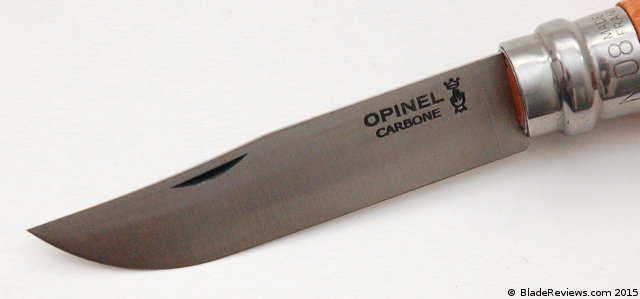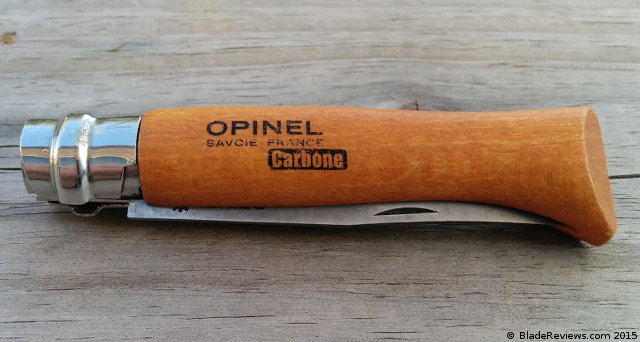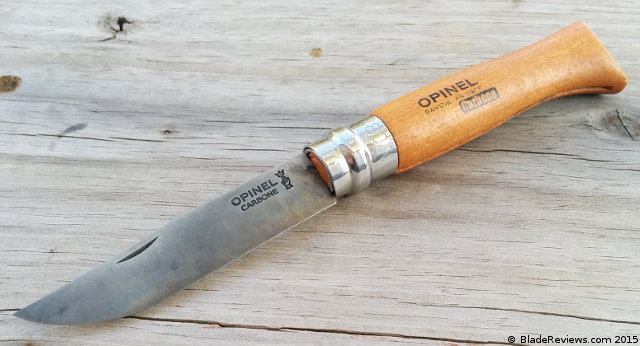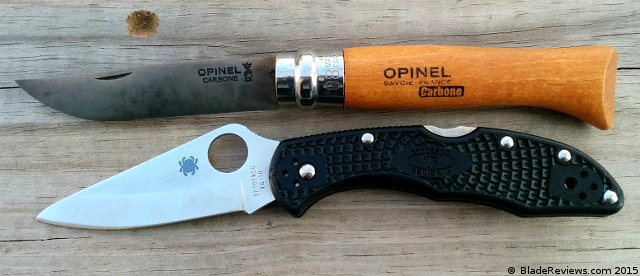This post contains affiliate links. We may get paid an affiliate commission if you buy something or take an action after clicking one of the links on this web page.
Do you want to hear another “the knife that got me into knives story?” No? Alright, I’ll spare you and just say that, a few years ago, it was the lines and material of the Opinel knife that caught my eye when I was wandering around labyrinthine hardware store/Boulder landmark McGuckin’s, and to this day I’m still plummeting headfirst down the rabbit hole.
There are certain objects whose design is so complete that they have an innate, immediate appeal to the mind; the Opinel is such an object. And even now, years down the road, after many permutations in personal taste, I still carry and use my first real knife, the Opinel No. 8.
General Dimensions and Blade Details
The Opinel No. 8 is made in France. Each knife in the main Opinel line is given a number that is the approximate length of the blade in centimeters: the No. 8 is historically the most popular size. My No. 8 has a blade length of 3 3/16”, a handle length of 4 3/8”, and an overall length of 7 5/8”; it weighs just 1.6 oz.
The No. 8 is comprised of just five pieces: the blade, the wooden handle, a steel collar around the pivot, a pin to keep that collar in place, and the rotating Virobloc locking ring, which fits over the steel collar. It’s a hoary old quote, but since it’s from a French writer and we’re talking about a French knife, it seems appropriate: Antoine de St-Exupéry once said that “A designer knows he has achieved perfection not when there is nothing left to add, but when there is nothing left to take away.” The five parts of the Opinel are all integral to its function; a single addition would be superfluous, and a single subtraction would impact performance. The smaller Opinels (nos. 2-5) lack the Virobloc ring, but with a blade as large as the one on the No.8, I think the lock is necessary.

That blade is a beautiful, sweeping clip point, with a glorious full flat grind, unadorned save for a nail mark, the words “Opinel Carbone,” and the famous main couronnée logo stamped close to the pivot. The length of the No. 8 allows for excellent food-slicing capabilities; generally I don’t cut food with my pocket knives, but the ease with which the No. 8 does it is impressive. Beyond food prep, although it doesn’t look the part, the No. 8 can perform medium-duty EDC tasks like breaking down boxes with grace: I used it to cut up a ton of cardboard and, besides a white-hot blade, I had no issues. It is also wonderful for whittling. It has been said in a thousand different places, by myself and others, but simple blade shapes are the best, and the Opinel is a textbook example of this fact.
This is a carbon steel model, made from XC90 steel. This a soft, durable carbon steel, and like all carbon steels can rust easily. It also sharpens easily-easier than any other steel I’ve ever used, in fact, including the famously easy-to-sharpen Victorinox steel. XC90 responds to the stones with a plasticity that is shocking if you’re used to more ornery modern steels: the No. 8 will go from dull to super sharp in ten minutes. XC90’s softness also means that it recovers from abuse quite well, tending to roll instead of chip. It also means, of course, that it doesn’t stay sharp for all that long, but with how easy it is to put an edge back on I find it hard to complain.
I will say, though, that when I pick up another Opinel, I will opt for a stainless steel model. Opinel’s stainless steel of choice is 12C27N, an excellent steel, especially when you consider how inexpensive an Opinel is ($15ish), that will significantly lessen rust issues, as well as eliminate the weird taste carbon steel imparts to food (I’ve had my No. 8 for years and I still notice it). And it will still sharpen up readily when the time comes. Carbon steel has its place in the knife world, but in my opinion that place is in big fixed blades; on an EDC folding knife, I think it’s a suboptimal choice.
Handle, Ergonomics, and Carry
The standard Opinel handle material is wood, and the standard wood is Beech, which is (I believe, correct me if I’m wrong, woodsmen) what mine is made out of. It offers decent traction without any sort of gimping or other modern considerations. The handle is a sort of piscine shape, with a gentle curve instead of aggressive scalloping or finger grooves, and this, along with its round shape, make for an excellent knife in the hand. It’s really a ‘grip-neutral’ knife: it works equally well in all grips. The spine of the blade is flat, allowing for a place to put your thumb for extra control, and the flat butt-end of the knife creates a good spot for your thumb in a reverse grip.

There is no clip, of course. And you probably knew this the minute you saw the knife, but its round, hand-filling shape, although great from an ergonomics perspective, is less than stellar in the pocket; this knife will take up quite a bit of room if you want to EDC it. I don’t have an issue with it, but I generally go pretty light on pocketables, so your experience may differ. The good news is that it is made out of durable materials and won’t get dinged or scratched up by your keys and other paraphernalia, and at 1.6 oz. is very light.

Deployment and Lockup
The nail mark tells you that this will be a two-hand-opening knife. I know that some two-hand knives (like the Pingo) can be kind of ‘cheesed’ into opening with one hand, but you’ll have no such luck with the Opinel No. 8: the blade buries deep in the handle, so there isn’t any place for your thumb to gain traction.
The good news is that the No. 8 is a smooth, effortless opener. Unlike a slipjoint, it has no spring putting tension on the blade, and so it comes out without a struggle; indeed, I rarely use the nail mark, instead just preferring to pinch the blade and pull. The only time I’ve had issues with it is when the wooden handle has swollen some; this creates some tightness, but it’s temporary and doesn’t render the knife unusable regardless.

The No. 8’s blade comes out so smoothly, in fact, that I would feel uncomfortable using with without the Virobloc locking ring. This is a proprietary Opinel feature, and is basically a ring around the pivot collar of the knife that, when the knife is either opened or closed, can be rotated around until it meets up against the tang of the blade and locks it either open or closed.
I like the Virobloc a lot. As with deployment, locking it is a two-handed endeavor, but speed isn’t something you should come to the Opinel looking for. I can only guess how it would stack up in strength against other locks, because I’ve never had a lock of any sort fail on me, but if you use the No. 8 for the tasks it was designed for, I don’t think you’ll ever have any issue with the Virobloc.
One interesting historical note: there is a traditional opening method for the Opinel, called the Coup de Savoyard. You tap the beak of the Opinel’s handle on a table so the blade jumps out a bit, and then open it. Not any faster than just opening it normally, but undoubtedly classier.
Opinel No. 8 Review – Final Thoughts
The Opinel No. 8 is a great knife. It has one of the best blade shapes in the world, and a comfortable, attractive handle. The two major issues I have with it-the choice of steel and the bulky carry-can be addressed by getting a stainless steel model in a smaller size. But even as it stands, years after I first picked it up, and after a hundred other knives have passed through my hands, I still come back to the No. 8, and every time I do I am pleasantly surprised-although maybe I shouldn’t be; great design doesn’t get outmoded after all, and I think the No. 8 is one of the inarguable masterpieces of our hobby.
- XC90 CARBON STEEL BLADE: Extremely hard thereby ing excellent cutting quality, good wear resistance, and easy regrinding. Carbon steel can corrode easily, maintain your knife by avoiding damp locations, and wipe and grease the Blade after use
- FLAGSHIP SIZE: The Number 8 is the most sold and versatile size in the ever-growing line of Opinel folding pocket Knives, earning its reputation as an everyday carry staple. 3.35” blade (8.5cm), open length 7.5” (19.5cm)
- PATENTED VIROBLOC: A hallmark of Opinel everyday carry knives since its invention in 1955, the Virobloc ring offers a unique, thoughtful, and easy to use safety mechanism for locking the blade during use, during Transport, and during storage
- SUSTAINABLE BEECH HANDLE: Our selection of wood is precise and meets strict standards for social responsibility and the environment. We select beech wood from ecologically managed French woodlands in the Alpine region and Jura Mountains
- AN ICON OF FRENCH CULTURE: Produced in the heart of the French Alps since 1890, Opinel knives draw simplicity and durability from their mountain roots. Opinel kitchen knives have been adopted worldwide and recognized as a design Icon
If you are thinking of buying an Opinel knife, I please consider purchasing it at Amazon.com. Please consider that buying anything through any of the links on this website helps support BladeReviews.com, and keeps the site going. As always, any and all support is greatly appreciated. Thank you very much.



Ben, welcome! Looking forward to more content on bladereviews; this was a great review of a classic. I had a stainless No8 and lost it; i wasn’t too sad, the North Carolina humidity swelled the handle up to the point of busting nails trying to open it in the summer. It’s a cool thing though.
Also, XC90 Steel? Does that mean it’s always broken and costs a fortune to fix like the Volvo of the same name?
Hey James,
Thanks for the warm welcome and the comment. That’s too bad about the handle swelling; I know I talked briefly about my experiences with that issue but depending on where you liveit can be a real dealbreaker. They do make Opinel knives with synthetic handles, but I believe they’re all the Outdoor model, with a half serrated blade (no thanks) and a weird-looking thumbhole for opening.
And I wasn’t aware of the Volvo connection; I’m sure it’s just a coincidence but part of me wishes it was actually just an instance of really awkward cross-promotion.
Ben.
When i get an new opinel i sand off the finish, dry it out (low temp hot air oven suffices) and then stick it into hot linen oil to soak that in good.
The finnish is smooth but grippy and swelling does not happen anymore.
Did you say somewhere that the model number represent the lenght of blade, in CENTIMETER ?
It would have been more understandable.
Suriya,
I agree and I updated the review to clarify. Thanks for reading.
Dan
Hey Ben,
Glad to see the review go up! It captured many of my feelings on the No. 8. I used mine for food prep pretty frequently, but my lunch breaks are almost always in the cab of a truck in a pistachio orchard, so I got into the habit of picnic lunches. The carbon taste it left behind didn’t bother me too much, but I can understand it being a drawback. The swelling issues are real – sometimes I could barely move the lock! But IMO the Opinel is cheap, classy, and functional. You’d be amazed at how popular they are worldwide – alongside the Swiss Army Knife and the Douk-Douk, they’re really icons.
-Grayson Parker
Hi Ben,
Love the opinels. I have owned several over the years. Currently a no 8 and a no 12 (the 12 is almost comically large, I use it in the garden). They are great utility knives, decent quality yet cheap enough to really “use” it. I usually pair either an opinel or a sak with a heavy duty folder or fixed blade. You also might be interested in the opinel with the horn handle. Beautiful knife.
Hey Arris,
Thanks for the comment. And I have definitely looked into the horn Opinels – they are absolutely gorgeous and come in stainless steel flavors. They’re definitely on my shortlist of Knives I Want.
It’s interesting to hear someone talk about the no. 12; I’ve always thought that it would have its uses: it seems like the Opinel is one of those knives that scales up and down really well: some knives don’t ‘work’ if you just make them bigger or smaller, but the Opinel maintains utility even at its biggest and smallest sizes – although I would have hesitations about buying the legendary no. 13 for anything but kicks.
I use the 12 as a portable chef’s knife. At that size, the blade is not thick enough to do heavy work, and the lock has its limitations. But for working on other people’s kitchens, the combination of the 7 I edc, and the 12 I keep in my travel bag, and I am good to create any dish.
Hey Andrew,
I’m not a chef, but I’m not surprised to hear the Opinel is a good kitchen knife. It slices like a demon and the steel is tough in the ways I imagine kitchen uses require.
Ben.
Good Review. I have two Opinel’s a no. 8 and 10, both in carbon. I tend to carry the 8 more than the 10. I use it as a general purpose knife and for skinning wallabies for meat. The blade shape is good for this task. Only have to ensure I wipe it clean and or lubricate the pin a bit so the blood doesn’t make opening difficult. A great traditional knife.
Hey Peter,
Thanks for the comment. Never had to skin a wallaby with my No. 8, but I can see the blade shape working quite well in that role. The pivot area tightening with moisture/getting stuck up with gunk is about the only thing you have to worry about on an Opinel – and as you say a little maintenance takes care of the problem. A great traditional knife that, in many ways, doesn’t feel like it can be ‘updated.’
To prevent the swelling of the wood in humid climates you can bathe or even deep fry the whole knife in linseed oil. Seals the wood and gives a nice finish. Just giving it a generous Ballistol coating and soaking it in the sun for a day should be enough to prevent the worst.
The carbon steel has become kind of outdated but the stainless variant works very well too. I especially like the Effile/Slimline series with its everyday picknick abilities.
Hey Emil,
I’ve seen this online before and considered doing it myself; it looks really nice when done properly. I do agree that the carbon steel models aren’t worth it. I chose a carbon model to get as ‘authentic’ an Opinel experience as possible, and I do like the way it patinas, but for all future models I’ll be going stainless.
Good review. I love Opinel. Own several sizes. Blade pivot can be lightened by expanding inner ring. I’ve done it on several of mine. Lock ring can be loosened in the same way. Simplicity is one of the positives of this knife.
To eliminate taste: force patina by soaking blade in cola for 30 min, wash, strop and olive oil blade.
For pre 2000 without lock close notch: remove lock ring and file ramp to engage closed blade.
Hey Don,
Thanks for the tip, I’ll have to give this a try. My No. 8 has a patina from a couple years of use but nothing complete enough to get rid of the taste. Maybe this is the trick. Next time I get the urge to tinker I’ll dunk my knife.
And you’re right, the simplicity of the Opinel is a huge benefit, both because it is easy to modify and because almost nothing can go really wrong with it.
Ben.
“Each knife in the main Opinel line is given a number that is the approximate length of the blade in centimeters”
Very approx , the No 8 is (officialy) 8.5 cm, the No 7 is 8 cm, the No 6 is 7 cm, etc. (the difference can be important in countries where the knife regulations limits the blade length).
Hey Kobaljov,
That’s interesting, thanks for pointing that out. I always assumed that the numbers were more precise than that, and that the explanation I offer in the review was direct from Opinel. Looking on their site now I don’t see this anywhere, so perhaps I picked it up in a forum or some otherless reputable source.
Ben.
Hi Ben, I would like to draw your attention to the Opinel gardening knife. It is basically a #8 with an elongated leaf-shape blade. I think they only come in the Inox version. For gardening duties this is quite appropriate. I have been using the ‘traditional’ Opinel for decades but really like the new stainless versions. Especially the gardening knife. I like to ‘shave’ a pair of flats on my handles. The beech wood is very easy to work & this can be simply done with some fine sandpaper. It doesn’t lessen the bulk much, the Virobloc ring is a limiting factor, but it does make the handle less likely to turn in the hand. Those who are inclined can take the shaping further. An interesting historical aside; the Wikipedia article on Opinel mentions that Pablo Picasso used this knife for his wood sculptures… ciao, fm.
Hey Foxtrot Mike,
I’ve seen the gardening knife before, and think it’s really cool. The spear point blade looks like it would be a pleasure to use too, although I would find it hard not to have the traditional Opinel clip.
Regarding carving, there are people who make all sorts of custom handles for Opinel knives. Whole websites are dedicated to their creations, and they look very cool. But you’re right, the practical advantage of beech wood being so easy to work with is that people can easily modify it to their taste.
I’ve heard that about Picasso before, and admit it was one of the things that drew me to this knife for the first time years ago. The Opinel has also been in museum exhibitions, and is included in a reference work from Phaidon about everyday design.
Ben.
If you’re in the market for a stainless Opinel, opt for the Opinel No. 8 Garden Knife. It’s the single most beautiful pocket knife I’ve seen, with an elegantly curved olivewood handle and a graceful spearpoint blade in a departure from the signature Opinel clip point. This is a knife made for useful work. It is insanely sharp out of the box, albeit less so than the carbon steel models. It’s going to be worlds sharper than most any other pocket knife out of the box, even the “famous” EDC brands, and it will hold that edge a looooooooong time. I typically lose them before I need to sharpen them, but when I hang onto one long enough where it goes dull, the Worksharp belt sharpener (with an aftermarket leather strop belt) touches up that convex edge easy as pie. Sixteen bux on Amazon.
(Number two is another of my three EDC folders, the Northfield EZ-Open Sunfish. Mine’s in stabilized bubinga, but only because I couldn’t find a polished bone or burnt stag model. It’s not a knife for the weak, and it’s about as intimidating as a garden trowel. It’s beautiful and durable and useful. My other EDC pocket knife is a Mercatur K55K in carbon tool steel with the original enameled steel handle, which is sublimely functional and comfortable, but kinda ugly.)
The Mini-Maglite (2 AA batts) sheath fits the #8 perfectly.
Picked up my #8 at the LL Bean store. They had white Oak handles then, that was two years ago. I have nearly closed the blade on my fingers several times as I cant keep the locking slip ring in position. I love the knife but I have to be very careful because as i do use it, the blade always works itself out of the “ramp” on the locking ring. Also as the knife moves around in my pocket the blade can easily become free because this ring is so free to move. Any fixes ??
Dave, Maybe the handle has dried out and shrunk? Possibly the answer is to soak it in linseed oil like the handle of an axe? Just a thought… never actually tried this.
Dan
Just pop the lock-ring off with a pair of snap-ring pliers and gently pinch the gap edges of the locking collar a little closer together. Re-install the lock ring on the knife and test for effect.
Opinels are excellent knives. I am partial to the carbon steel. I have the no.8 and 9. One error on your part tho. The carbon steel in These knives sharpen easily because of their high carbon content, not because the steel is “soft”. Fact is these Opinel carbon blades are hardened to about 60 on the RC scale which is quite hard.
Rust specks on carbon steel can be easily removed by rubbing with wetted aluminium foil.
The toe of the handle is designed such that opening the knife is easy with a sharp tap even when the wood is wet. It will free the blade sufficiently to grab it between two fingers. In France they are known as the ‘Tap Opinel’
I am glad that you folk like them, but for myself, I can find nothing to like about an Opinel. They are too flimsy for real work, the blade is to soft, and the handle too slick, opening and closing them is tedious. They may be good for cleaning your toenails, but beyond that, I consider them something you would expect to get out of a gum machine. Now that they have risen in Price to nearly $20.00, there are a lot better options, maybe even from Pakistan. 😉
My favorites are the # 10’s; one in carbon and the fillet model in stainless which I use on fish & birds. I removed the varnish from both handles, sanded down to 400 grid, then oiled with boiled linseed oil for a slightly ‘finer’ look. They are fabulous knives in their simplicity.